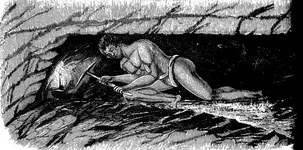Are You Saying...Only Pennsylvania...Was Capable of Digging Tunnels...In 18th Century
I continue to watch the Oak Island show. I really wish they would devote one half episode as to how they think anyone with a wooden shovel could dig that deep and then booby trap it as well as digging out a cavern to build a vault for these treasures. Like I said before, I really like the brothers and guys on the show and I am rooting for them but why on earth would anyone bury something so deep and how would you ever get it back if you wanted too? I really believe nothing ever will be found. Nothing in terms of priceless historic artifacts.

One of the earliest mentions that coal might be found in the Pennsylvania area dates back to 1698, when Gabriel Thomas wrote an account dedicated to William Penn. He notes the possibility of coal because the running water had the same coloring as the water in the coalmines in Wales. The actual presence of coal is first recorded on a map made in 1753 by John Pattin, an Indian trader, although it is possible he did not detect the coal first hand, but rather heard about it from other traders. Soon after, in 1754, George Washington led an expedition across the
Allegheny Mountains, and his second-in-command wrote a letter detailing an abundance of natural luxuries including coal in the western region of Pennsylvania. Then in 1761, the first actual Pennsylvania coalmine is recorded on the “Plan of Fort Pitts and Parts Adjacent” map. The bituminous mine was located in Fort Pitt near the top of Coal Hill, which is now downtown Pittsburgh. Anthracite coal was first found in 1762, and then was used for the first time around 1769 by Obadiah Gore and his brother in their blacksmith shop in Wilkes-Barre. However, coal usage was generally restricted to local consumption need until the industry began to expand at the turn of the 19th century.
The first discovery of the anthracite coal occurred in 1762, and the first mine was established in 1775 near Pittston, Pennsylvania. In 1791 Anthracite was discovered by a hunter atop
Pisgah Ridge, and by 1792 the
Lehigh Coal Mining Company began producing and shipping coal to Philadelphia via
Mauch Chunk from the Southern Anthracite Field and
Summit Hill, Pennsylvania, built atop the line between
Schuylkill County and what would be renamed
Carbon County.
Luckily the
Oak Island Depositors in 1700s used the best miners known in the
World...
Cornish Tin Miners...Born and Bred for this
Job!











